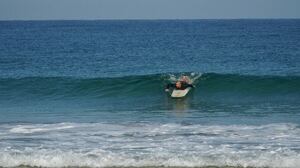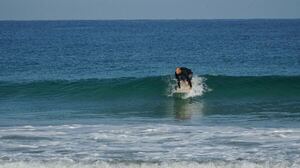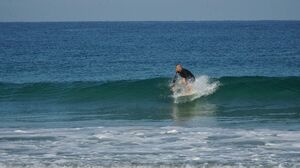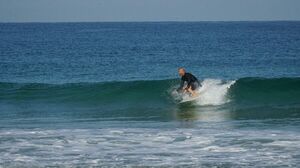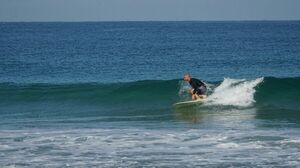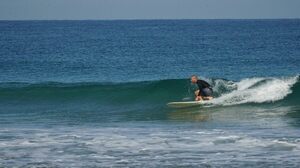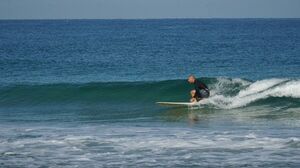MASTER CLASS (1/6)- Paddling for a wave
Publié le : 8 février 2022 à 17h40
MASTER CLASS (1/6)- Paddling for a wave
How to surf better with Kevin Olsen.
Learning the fundamentals of surfing and taking your surfing to the next level is everything- so by implementing these simple techniques to your everyday surfing you can change your surfing forever. I will be sharing my coaching knowledge and what technical programs I use to surf better and have applied to my surfing over the years to constantly improve. These programs are directed towards mostly beginners and intermediate surfers, however the breakdown of these programs are systematically identical for all surfers meaning we all have to go through the same motions to improve.
They say "practice makes perfect "
Well I say « perfect practice makes perfection »
a) Identify the take off spot and your positioning in the water:
b) Wave selection: Yes or No.
c) Turning and Timing: when the perfect wave is approaching you when do we turn and which way do you paddle?
d) Good paddling = good surfing and I always say about 5 good paddles will get you the wave.
e) Catching the wave: All the beginners always ask me "When do we catch the waves?
f) Pop-up: the most important element and consists of 3 stages for beginners.
g) Stand up and drop the in: your pop-up to your feet should be lightning fast and done properly every time.
h) Bottom turn: Once you have successfully made the drop-in your should immediately strive to reach the bottom of the wave with your knees bent and center of gravity low.
i) Now you start surfing.
This week we focus on 'paddling for a wave’ and everything that comes into catching the wave of your dreams.
For this experiment or moment in time can you imagine that there is nobody in the water? It’s only you and perfect waves.
Paddling for a wave and where do we start? Well it's a simple process for all surfers and needs to be 'respected and done in order’ to achieve to best results. From reading the approaching wave to paddling and moving at the same speed of the wave - it’s the same process for everyone.
This is my breakdown:
a) Identify the take off spot and your positioning in the water: getting into position or entering the lineup is super important and I always use a marker on the beach like my bag or a certain point of reference to keep going back too. Maybe its a certain piece of drift wood or a house etc
You need to identify this point (every session) and keep going back to it. You can also call it your Marker.
My tip: if there is a very strong current then get out the water and reset. Find your Marker and start again, because this will ultimately help you catch more waves with better positioning.
b) Wave selection: Yes or No.
If "yes" the wave selection should be done when the wave is about 10 meters in front of you. Always try and choose the best wave that is coming towards you or moving in your direction which makes paddling and catching waves much easier. Of course moving/paddling with the wave and the energy of the swell will always help and up your wave count which results in more waves surfed per session. So paddling strong and moving in the same direction as the waves by trying to catch the energy of the wave is key.
If your selection was "No" then just paddle over the wave or wait for the next perfect wave to come your way.
My tip: The first wave of the set is not always the best one. Leave the others to paddle for the first wave and get out of position. You can enjoy the fruits of the rest of the sets.
c) Turning and Timing: when the perfect wave is approaching you when do we turn and which way do you paddle?
Reaction is key. You want to react early, turn quickly and start paddling immediately after you select your wave and ideally paddling in the same direction as your moving wave to connect with the energy of the wave. We always want to put a little extra effort into your 'paddling and catch' the waves before they break so positioning in the lineup is important. Position yourself about 5-10m behind the take spot and ideally we need to paddle and catch the wave at the apex of the breaking wave. All surfers should aim to start on top and ride down the open face of the wave.
My tip: Never start paddling to early as this will only result in you going over the falls in a late takeoff.
d) Good paddling = good surfing and I always say about 5 good paddles will get you the wave. About 5 good and powerful strokes will get you moving and moving at the same speed of the wave is very important. If you paddle properly and get moving then you connect with the speed of this moving wave.
If you put the effort in and concentrate on your paddling technique then you build strength with your arms to catch more waves.
Good paddling can also mean more commitment. Commit and go- don’t half heartedly commit and fail to generate any sort of speed from no real effort.
So 5 or 6 good powerful strokes into the wave is best.
2-3 paddles is weak and is just not enough.
8-9 paddles just means you will get tired sooner.
My tip:Good paddling = good surfing. No paddling = no surfing.
e) Catching the wave: All the beginners always ask me "When do we catch the waves?
Well once you have properly paddled and you can feel the energy of the wave pick you up, push you forward and and you can feel this « dropping in or falling feeling.
After this feeling you can try to stand. We are about to catch the waves energy source and the waves power is about to push the surfer forward and it’s at this point you want to prepare to pop up.
My tip: If you can learn to feel the push from the wave- thats the secret.
f) Pop-up: the most important element and consists of 3 stages for beginners.
You need to develop and improve your pop-up which should be done in 1 quick step or 1 second.
For beginners the 3 stages are:
1) hands under your shoulders and use your strength to push yourself up.
2) jump up/ pop up and move your feet into the correct position which is about shoulder width apart.
3) stand on your feet (not your knees) and stand up with your shoulders and your head above the surfboard.
Now I know this sounds simple, but I see plenty of surfers that could improve their pop-up by just practicing these 3 movements on the beach before they go surfing.
If it takes you 3 seconds to achieve your pop-up in the water well then practice it on land to improve to 2 seconds and eventually 1 second. Do it everyday.
My tip: your ultimate goal for the pop up is 1 second.
g) Stand up and drop the in: your pop-up to your feet should be lightning fast and done properly every time.
Your feet should be about shoulder width apart and placed in the correct position on the surfboard. Bend your knees, look forward and start committing to the drop in.
Imagine skate boarding and learning to drop-in on a 10 foot skate ramp. Your feet position must be perfect and your knees need to be flexed and bending to absorb the gravity of your drop-in. Bending your knees is everything here - along with commitment. Commit 100%. Look which way you are planning to go.and keep your eyes on the wave.
My tip: bend your knees to improve your balance.
h) Bottom turn: Once you have successfully made the drop-in your should immediately strive to reach the bottom of the wave with your knees bent and center of gravity low.
By going from the top of the wave to the bottom of the wave you can generate amazing amounts of speed here and this can setup the rest of your wave.
Important points to remember here are bending your knees (like the skate boarder dropping the skate ramp) bend down low and even learn to touch the water/wave face with your trailing hand. Use the information gathered from a visual aspect to always improve your wave riding skills and plan your turns ahead of time.
My tip: Go for it - get very low and touch the water. Always remember to look and read the waves open face.
i) Now you start surfing: At this point (hopefully) we have done everything possible and in sequence to focus our attention to 'Paddling for a wave’ now the surfing begins.
I hope this information and breakdown helps you and remember it’s the basics that are most important to catch more waves and surfing better.
